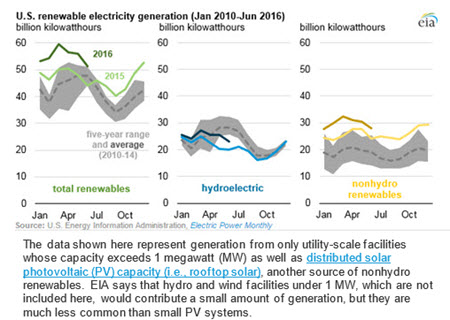WASHINGTON, Sept. 8, 2016 - Renewable electricity generation has surpassed levels from previous years in every month this year through June, based on Energy Information Administration (EIA) data that includes conventional hydro and nonhydro sources, such as wind, geothermal, biomass and solar.
After a lengthy West Coast drought, EIA says that hydro generation has increased and is now closer to historical levels.
Annual hydro generation in 2015 was at the lowest level since 2007, EIA says, largely because of drought conditions in the Pacific Coast states.
 According to EIA, the three continental Pacific Coast states
(California, Oregon and Washington) contain 50 percent of total U.S.
conventional hydro capacity.
According to EIA, the three continental Pacific Coast states
(California, Oregon and Washington) contain 50 percent of total U.S.
conventional hydro capacity.
EIA’s data shows that nonhydro renewable generation has been steadily increasing over recent years as more capacity has been installed, especially wind and solar photovoltaics (PV). In 2013, the total annual generation from nonhydro renewable sources surpassed hydro generation for the first time, EIA says.
Nonhydro renewable sources (including distributed generation from rooftop PV) collectively exceeded 10 percent of the monthly electricity generation mix for the first time in March and again in April. EIA notes March and April typically have moderate weather and thus relatively low electricity demand.
EIA’s data shows that capacity additions for nonhydro renewables have collectively accounted for most of the electric capacity additions over the past three years in the U.S. The agency says capital costs of solar and wind facilities have declined considerably in recent years.
Other factors in the growth of nonhydro renewable capacity include policy-based incentives, such as state renewable portfolio standards and tax credits. EIA says that key tax credits, such as the production tax credit and the investment tax credit, have generally been in effect over the past several years and were extended in December 2015.
#30
For more news, go to: www.Agri-Pulse.com

